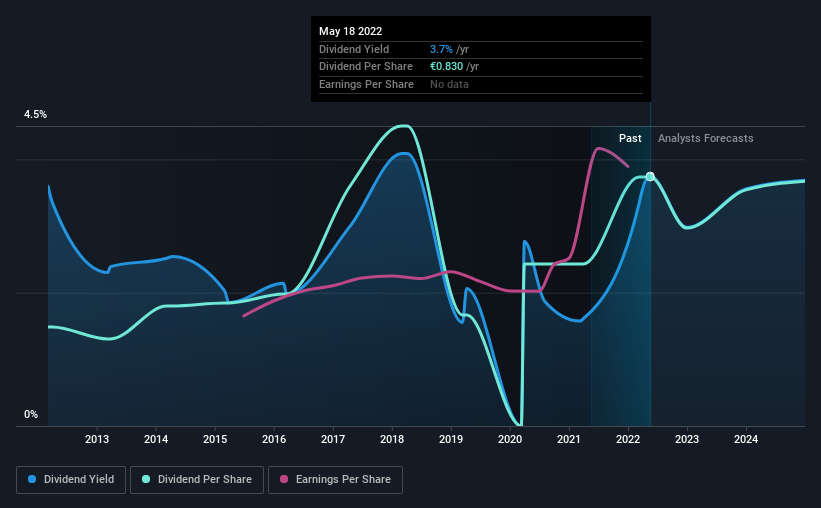[ad_1]
It looks like De’Longhi S.p.A. (BIT:DLG) is about to go ex-dividend in the next three days. The ex-dividend date is usually set to be one business day before the record date which is the cut-off date on which you must be present on the company’s books as a shareholder in order to receive the dividend. It is important to be aware of the ex-dividend date because any trade on the stock needs to have been settled on or before the record date. Therefore, if you purchase De’Longhi’s shares on or after the 23rd of May, you won’t be eligible to receive the dividend, when it is paid on the 25th of May.
The company’s next dividend payment will be €0.83 per share, and in the last 12 months, the company paid a total of €0.83 per share. Looking at the last 12 months of distributions, De’Longhi has a trailing yield of approximately 3.7% on its current stock price of €22.14. Dividends are an important source of income to many shareholders, but the health of the business is crucial to maintaining those dividends. As a result, readers should always check whether De’Longhi has been able to grow its dividends, or if the dividend might be cut.
View our latest analysis for De’Longhi
Dividends are typically paid from company earnings. If a company pays more in dividends than it earned in profit, then the dividend could be unsustainable. Fortunately De’Longhi’s payout ratio is modest, at just 40% of profit. Yet cash flow is typically more important than profit for assessing dividend sustainability, so we should always check if the company generated enough cash to afford its dividend. Dividends consumed 53% of the company’s free cash flow last year, which is within a normal range for most dividend-paying organisations.
It’s positive to see that De’Longhi’s dividend is covered by both profits and cash flow, since this is generally a sign that the dividend is sustainable, and a lower payout ratio usually suggests a greater margin of safety before the dividend gets cut.
Click here to see the company’s payout ratio, plus analyst estimates of its future dividends.

Have Earnings And Dividends Been Growing?
Stocks in companies that generate sustainable earnings growth often make the best dividend prospects, as it is easier to lift the dividend when earnings are rising. If business enters a downturn and the dividend is cut, the company could see its value fall precipitously. Fortunately for readers, De’Longhi’s earnings per share have been growing at 11% a year for the past five years. De’Longhi is paying out a bit over half its earnings, which suggests the company is striking a balance between reinvesting in growth, and paying dividends. This is a reasonable combination that could hint at some further dividend increases in the future.
Many investors will assess a company’s dividend performance by evaluating how much the dividend payments have changed over time. Since the start of our data, 10 years ago, De’Longhi has lifted its dividend by approximately 9.7% a year on average. We’re glad to see dividends rising alongside earnings over a number of years, which may be a sign the company intends to share the growth with shareholders.
The Bottom Line
Has De’Longhi got what it takes to maintain its dividend payments? From a dividend perspective, we’re encouraged to see that earnings per share have been growing, the company is paying out less than half of its earnings, and a bit over half its free cash flow. De’Longhi looks solid on this analysis overall, and we’d definitely consider investigating it more closely.
While it’s tempting to invest in De’Longhi for the dividends alone, you should always be mindful of the risks involved. Our analysis shows 2 warning signs for De’Longhi and you should be aware of these before buying any shares.
A common investing mistake is buying the first interesting stock you see. Here you can find a full list of high-yield dividend stocks.
Have feedback on this article? Concerned about the content? Get in touch with us directly. Alternatively, email editorial-team (at) simplywallst.com.
This article by Simply Wall St is general in nature. We provide commentary based on historical data and analyst forecasts only using an unbiased methodology and our articles are not intended to be financial advice. It does not constitute a recommendation to buy or sell any stock, and does not take account of your objectives, or your financial situation. We aim to bring you long-term focused analysis driven by fundamental data. Note that our analysis may not factor in the latest price-sensitive company announcements or qualitative material. Simply Wall St has no position in any stocks mentioned.
[ad_2]
Source link








